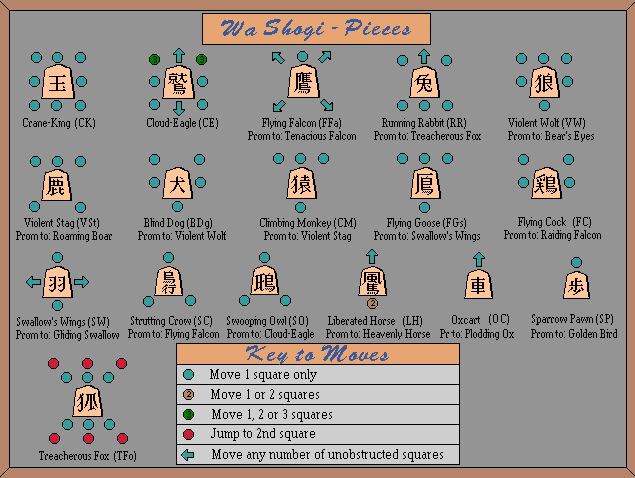Wa Shogi (Yamato Shogi)
Wa Shogi is first mentioned in literature in the 17th century. The pieces are all named after birds or animals, and the names are very whimsical (even by Shogi variant standards).
Other than the initial board setup and moves of the pieces, little definite is known about the game. It is assumed that in most respects the rules were identical to Shogi, but it is unclear whether or not the game was played with drops.



(From Steve Evans, corrected)
SHORT DESCRIPTION:
Wa Shogi is played on a board of 11 x 11 squares and each player has 27 pieces.
The object is to capture the opposing Crane-King.
The Treacherous Fox and Heavenly Horse are the only pieces in Wa Shogi that have the power to jump over occupied squares. The Treacherous Fox may jump to the second square in any of the directions. The Heavenly Horse can jump in the same way as a Knight in Western Chess, but only in the forward and reverse directions.
The Cloud-Eagle can move to the second or third squares on the forward diagonals only if the intervening squares are vacant. The Liberated Horse can move to the second square in the reverse direction only if the first square is unoccupied. The Cloud-Eagle and Liberated Horse are therefore not Jumping pieces.
Promotion: each player has a Promotion Zone consisting of the three ranks (rows of squares) furthest away from him. All pieces except the Crane-King, Cloud-Eagle and Treacherous Fox have a promoted rank and can promote on entering, moving within, or leaving the Promotion Zone. Promotion is not compulsory unless the piece would be unable to make a further legal move in its unpromoted state. The Sparrow Pawn and Oxcart must therefore promote on reaching the last rank.
Drops: it is not known if this game was intended to be played with drops or not. In the affirmative case (historically less probable), it is supposed that the rules will be the same than for Shogi. Then, it comes:
All promoted pieces revert to their unpromoted ranks when captured.
In general, a piece held in hand may be re-entered on any vacant square, subject to the following restrictions:
- A piece may not be dropped on a square from which it has no further legal move. (ie: a Sparrow Pawn or Oxcart can not be dropped on the last rank).
- A Sparrow Pawn can not be dropped in any file (column of squares) already containing an unpromoted Sparrow Pawn of the same side.
- A Sparrow Pawn can not be re-entered directly in front of the opposing Crane-King so as to give instant checkmate.
A piece dropped inside the player's Promotion Zone is not promoted until after it has made a further move on the board.
HISTORY:
Wa or Yamato Shogi is cited by John Fairbairn in his important paper about Shogi Variants. He said that it is a special case. The three sources of it in the literature are so contradictory as to imply there were completely different ways of playing it. One version (in two sources, but both differing: Shogi Zushiki [late 17th c] and Kokon Shogi Zui [late 17th c.]) has pieces with generally very limited powers. This, some fragmentary linguistic evidence in Kokon Shogi Zui and its possible date make it not impossible that it was played with drops. The other version, from Sho-shogi Zushiki [1694], has many long-range pieces, which could rule out drops. And there are other important differences (which are unknown to me for the moment).





